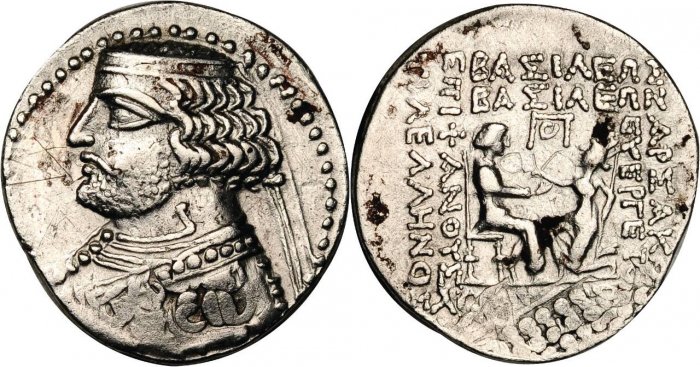57 BCE - 37 BCE | BAΣIΛEΩΣ/BAΣIΛEΩN APΣAKOY EYEPΓETOY ΔIKAIOY EΠIΦΛNOVΣ ΦIΛEΛΛHNOΣ
|
|
Sale(s)Sale(s) ᵖ:
|
Triton XIII, 05 Jan. 2010, 635; Stack's Bowers Galleries, 154, June 2010, 8078
|
|
|
|
Description
| ObverseInscription or printing placed on the obverse.:
|
Bust left, wearing torque ending in sea-horse or griffin, diadem and drapery. Border of dots.
|
ReverseInscription or printing placed on the reverse.:
|
BAΣIΛEΩΣ/BAΣIΛEΩN APΣAKOY EYEPΓETOY ΔIKAIOY EΠIΦΛNOVΣ ΦIΛEΛΛHNOΣ (Greek) Orodes enthroned right, raising up kneeling Tyche, who raises right hand and cradles scepter in left arm. Above, ΠO monogram.
|
Mint and issuing power
Chronology
| FromIdentifies the initial date in a range assigned in a numismatic context. 57 BCE toIdentifies the final date in a range assigned in a numismatic context.. 37 BCE
|
Hellenistic 323-30 BC  periodTime period of the numismatic object. periodTime period of the numismatic object.
|
Physical description
MetalThe physical material (usually metal) from which an object is made.: Silver 
|
WeightWeight of the numismatic object (in grams). in grams: 15.2315.23 g <br />15,230 mg <br />
|
DenominationTerm indicating the value of a numismatic object. Examples: tetradrachm, chalkous, denarius.: tetradrachm 
|
AxisDescribes the directional relationship between the obverse and reverse of a numismatic object.: 1212 mm <br />1.2 cm <br />
|
|
|
|
References
Description
| ObverseInscription or printing placed on the obverse.:
|
|
ReverseInscription or printing placed on the reverse.:
|
|
Mint and issuing power
| MintIdentifies the place of manufacture or issue of a numismatic object. ᵖ:
|
|
Ancient regionAncient region. ᵖ
|
|
Modern countryModern country:
|
AuthorityIdentifies the authority in whose name (explicitly or implicitly) a numismatic object was issued. ᵖ:
|
|
Chronology
| FromIdentifies the initial date in a range assigned in a numismatic context. toIdentifies the final date in a range assigned in a numismatic context..
|
periodTime period of the numismatic object.
|
Physical description
References

